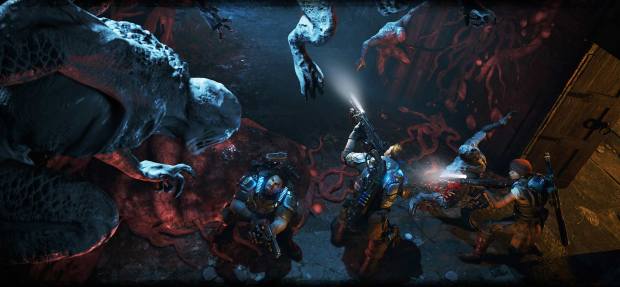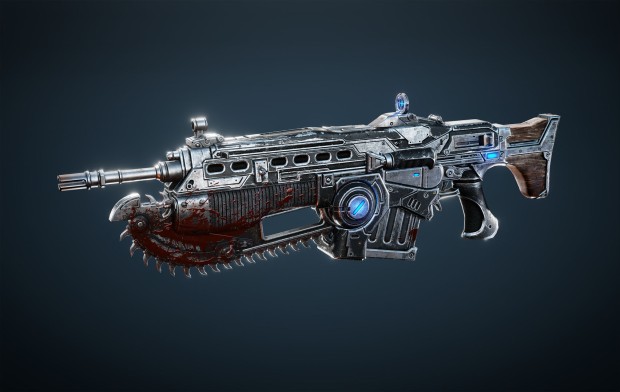Gears of War – “Zen and the Art of the Active Reload”
Gears of War 4 has been a thoroughly enjoyable experience for me and my homies since it released in early October 2016. Having played every single Gears of War title for the various Xbox consoles, I’ve been relatively ok with the fact that every single Gears game has been more-or-less a “rehash” of the original title.
Now I know that “rehash” is a semantically charged and negative term, but Gears really seems to fit the bill with this label whilst upholding the notion of “if it ain’t broke, don’t fix it.”
See, every single Gears game has felt more or less very similar in terms of mechanics, weapons, objectives, and level design. This isn’t necessarily bad, but it really only entices me to play a new one if spaced out years apart. Unlike Halo titles, which often change mechanics and features dramatically between iterations, I know that a new Gears title will be a safe bet.
This consistency in mechanics within the Gears franchise has provided one of my greatest advocacies among game design, and in truth, one of my favorite gameplay mechanics.
**Cover-Based Shooter Mechanics in a Cover-Based Game:**
From its inception, Gears has always been very self-representative as a cover-based shooter. Each map is constructed almost like a grid, as movement in Gears operates most functionally on a grid. One hits the A button to “Roadie Run” in a generally straight line from one piece of cover to the next.
This allows players to self-pace their gameplay a bit better than most other games, and it places a large emphasis on giving players room to breathe in between engagements.
This ability to self-pace combat and effectively disengage behind cover allowed the game designers to introduce a gameplay mechanic that I have never seen in any First or Third-Person Shooter before it or since: the Active Reload.

When the shit hits the fan, the Active Reload moves from a simply timed mechanic into a frenetic resource requiring precise management.
**How the Active Reload Works:**
The Active Reload takes a passive control – the act of reloading one’s weapon – and instead of making it a simple button press, Gears turns the reload into a small mini-game. This mini-game is timing based. It has a passive state, a pass state, a fail state, and a reward state.

Breaking down the Active Reload: 3 zones and the single slider.
- The Passive state functions as if the reload was a single button press (engaged with the right bumper, RB, button). You can see in the UI exactly how long the reload for that particular weapon will be. This means that simply hitting reload once will reload your weapon passively on its own.
- The Pass State requires 2 button pushes of the RB, reload button. Pressing it once to begin the reload, and then once again when the reload slider is within the “pass zone” will allow players to more quickly complete the reload on that weapon.
- The Fail State is when the RB, reload button is pushed a second time outside the white perimeter, and results in the weapon jamming. This means that by trying to time your reload accurately and failing, you’ve increased the length of time it takes to reload even beyond the time the regular, passive reload would have taken.
- The Reward State is the majority of the incentive behind even attempting the Active Reload in the first place. By hitting the reload slider perfectly on the very small reward state, the amount of bullets reloaded into your magazine receive a damage boost (perhaps of 20% or so).
These 4 components work together to create a risk assessment with certain weapons, as the fail, pass, and reward state actually differ greatly in size, and the speed at which the reload slider moves also varies.

The Lancer is the quintessential Gears weapon, and its active reload has been consistent for over a decade. Locking into that flow unlocks the full potential of this beautiful beast.
**Gameplay Benefits to Enabling an Active Reload:**
The Active Reload exists to gamify a relatively simple mechanic, and in turn has many gameplay benefits.
- It takes a passive action and makes it into an engaging mechanic centered around timing and rhythm.
- It takes a binary action and makes it more challenging, while still using only one button.
- It takes a zero-reward outcome and makes it into a mechanic that has a fail, pass, and bonus/reward state!
- It creates pressure and intensity where other games’ reloads have relatively none.
- It increases the skill ceiling – in MP, two equally skilled players can have a fight boil down to how well one timed the active reload.
- It increases flow and actually makes players more proficient in their combat.
**Flow and Fluidity in the Active Reload:**
My last point is around the concept of “Flow”. Studied both academically and referred by colloquial terms for many years as being “in the zone”, “hitting the sweet spot”, “locking into a groove”, Flow is a phenomenal experience to feel and a provocative concept to ponder.
Flow has been studied by multiple researchers but was initially coined by a psychologist named Mihaly Csikszentmihalyi; it refers to the hyper-focused state of mental presentness one enters for proficiency-demanding tasks. That is to say, Flow states are entered when one’s success in a relatively challenging task becomes proficient to the point where the effort to accomplish that task is less based in direct conscious action, and more geared towards timing, rhythm, and automation.
Entering Flow can often lead to an ideal state of learning, and if subsequent tasks have similar qualities to the Flow-focused task, they may also benefit from a higher level of success.
One of my favorite things about Gears’ Active Reload is that it aids in the process of entering a state of Flow. It demands timing for to be successful, and while each new weapon has a different timing, the initially conscious action of hitting that sweet spot in the reload becomes second nature as you’ve locked in 2, 5, or 10 reloads in a row.
**Lockin’ in on that Sweet Spot:**
It’s a lovely feeling. Reload after reload. Locking into a perfect timing. What starts as an activity best done from behind cover with eyes glued attentively to the UI quickly becomes a combination of timing and a quick glance to the top right of the screen.
Early on in the Campaign, I was not attentive to the Active Reload. Upon deciding to actually try and hit *all* my Active Reloads (thanks for the motivation, Achievements), I noticed that my aim actually tended to improve. It was almost as if my momentum from the success in a small task carried over to the larger focus of aiming my weapons.
Headshots became more satisfying. Weapon switching and bouncing into and out of cover felt smoother, more responsive. I wonder if there’s any overarching games research into the concept that success in a small task immediately increases a likelihood in a subsequent, semi-related task? After all, there’s timing in tracking moving targets on-screen and knowing the precise moment to hit the trigger on one’s follow up shots.

Can success in timing generate momentum towards success in subsequent tasks? Is the power of combo kills an actual effect? Is the Active Reload tapping into a mastery-assistance mechanic that few other games are tackling?
Can success in timing generate momentum towards success in subsequent tasks? Is the power of combo kills an actual effect? Is the Active Reload tapping into a mastery-assistance mechanic that few other games are tackling?
As soon as I started hitting a state of Flow with my reloads, it seemed like I was one step closer to entering a state of Flow with the overall gameplay in Gears. I’d potentially even argue that Gears gameplay isn’t Flow-optimized for me due to its run/roll/cover à engage à run/roll/cover à engage style of combat. The freedom of movement isn’t necessarily there or free-flowing in the way I normally like (peep my DOOM review for an analysis on a game that creates opportunities or Flow ideally for me).
Nonetheless, it’s the very gamified and Flow-enabling element of the Active Reload that, when I’m mindful to hit accurately, allows me to inch ever closer to that glorious, oft-desired Flow state.
**TL;DR**
The Active Reload for Gears is so dope for adding skill to a passive control, increasing the skill gap, and pushing players towards a state of flow by allowing mini-successes to carry on to subsequent combat and aiming. It’s a neat little gameplay mechanic that has a huge depth of potential, and I’d love to see more mechanics that embody elements of the Active Reload carried over onto other games.
**Gameplay Design Worth Advocating For:**
- Active Reloads as a gameplay mechanic increase activity and engagement.
- Active Reloads increase the skill gap in MP by tasking timing upon traditionally simple mechanics.
- Active Reloads create pressure, add an element of immersion, and create a pass/fail/reward state.
- Small, Flow-enabling tasks that can be placed intuitively and smoothly between gameplay may improve aiming and success in subsequent tasks. This point could be bolstered by controlled experiments or further research into how success in one task creates momentum for success in other tasks.
- Seeing mechanics like this enabled wisely into other games could work to provide very interesting results.
- There are plenty of other passive elements that can re-work their mechanics in a similar fashion. The act of swapping weapons, using healthpacks, or repairing equipment could also be placed on a timing pass/fail/reward state. When VR peripheral become adequate substitutions for controllers, the act of actually simulating a reload may become a very natural and intuitive version of the Active Reload.
e-vaughn
Citations:
- All images taken from the official advertising site of Xbox.
- Active Reload image found online and modified for analysis.
Comments and Questions? Hit us up!
Pingback: Why do Sequels Drop Design Mechanics? -Comparing Titanfall 2 vs. Titanfall 1 | Hopeful Homies